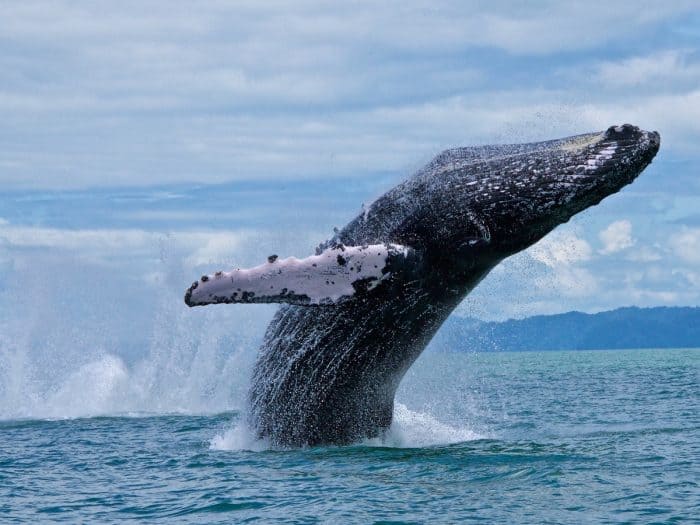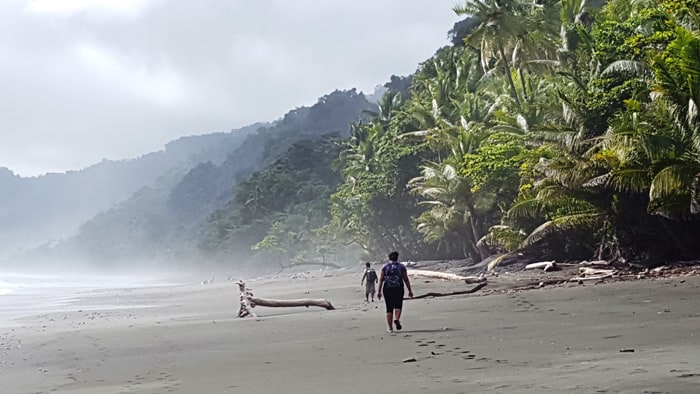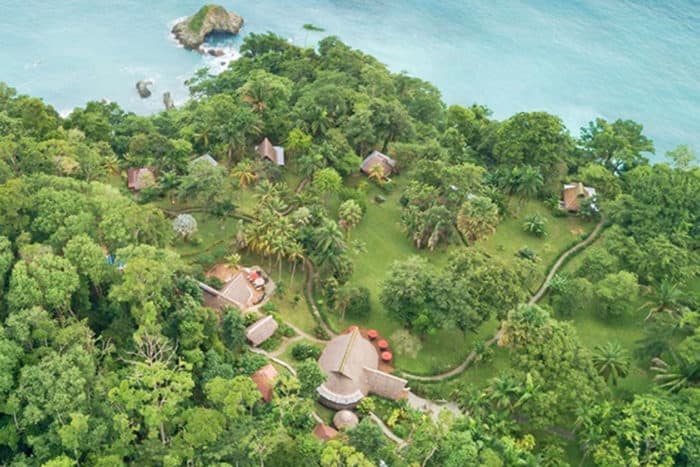There is something magical about where forest meets the sea. The 11-kilometer coastal trail from Drake Bay to Corcovado, on southwestern Costa Rica’s Osa Peninsula, passes by towering giants surrounding rocky points pounded by Pacific waves. Broken only by wild beaches of all sizes, two small rivers and countless small streams, the trail is completely free of roads and cars. As you hike along the narrow path toward Corcovado, you walk back in time, and hopefully catch a glimpse of the future.
Walking in Costa Rica
Walking is a way of life here. And I don’t mean strolling down the sidewalk – there are no sidewalks. There is no pavement of any kind, although some muddy sections sport stepping-stones. There are two small footbridges, one hanging bridge across the Río Agujas, and one tiny span over a nameless rushing stream. The rest of the trail is stone and earth, blanketed in leaves of a surprising variety of colors
With each step away from Agujitas town in Drake Bay, the forest becomes thicker. The sounds of people fade away and are replaced by a concert from the forest and the sea. The scarlet macaws, whose population here is one of the largest on earth, can be louder than any car alarm, the sound of the crashing surf more powerful than that of a passing bus or train, the roar of the howler monkey stronger than any neighbor’s thumping bass.
The sounds are accompanied by scents, also quite different from those in town. A menagerie of blossoms emits a bouquet of fragrances blown about by the ocean breeze. The thick, earthy smell of the forest mixes with the heady ion and ozone smell of water from the foaming surf and gushing waterfalls. Fruits of all sorts add their spicy, wild aromas.
The Views

The views, too, are wild – unbroken, endless, to-the-horizon wild, an infinity of greens and blues painted with streaks of copper, beige or bronze sands. The sunsets here often suffuse the air all around with a golden glow that many people describe as unique to the area. Repetitive cloud formations over the 700-meter Agujas Peak often shine with double rainbows over the rain forest. Look the other way and you will see the sun setting into the fiery Pacific around distant Caño Island, with the clouds above lit with more colors than the rainbows.
Gazing at the sea from this trail, you are likely to see a humpback whale or two, or more. Groups of spotted dolphins hunt daily along this coast, often only meters off the rocks and beaches. Pseudorcas and orcas also cruise the rocky points, hunting big roosterfish. This stretch of coastline is the best in Costa Rica to sight cetaceans from the shore.
For these same reasons, you might also catch a glimpse of some of the finest yachts in the world as you hike Costa Rica’s wildest coastal trail. The vessels come from all over the world to sail and anchor off this stretch of coast. You may come across campesinos carrying supplies by horseback next to billionaires having a beach picnic.
Meeting Hikers
You might also meet ecotourists from all over the world who are staying at hidden hotels along the way. Some of the coolest eco-lodges in the world are tucked away along this wild trail. Luxury is not the call here; guests come for comfortable quarters that showcase the wild surroundings.
The new buzzword for this sort of thing seems to be “neorustic,” and judging from the occupancy rates of hotels here compared to many other areas, neorustic is a very hot trend in tourism.
That’s good for the Osa in particular and Costa Rica in general. Neorustic also tends to mean low-impact, sustainable, low-investment, rural tourism. Neorustic is kind of what Costa Rica is all about, really. One of the country’s greatest contributions to global culture is teaching the world that when you revere the wild, you are content to live simply. No fancy spread is necessary when your natural surroundings are healthy. Costa Rica is a neorustic torch, lighting the way to a healthier, happier path.
Nowhere on the rich coasts of Costa Rica is that neorustic torch burning brighter than on the coastal trail from Drake Bay to Corcovado National Park.
Take a walk on the wild side of Costa Rica
Domestic airline Sansa (www.flysansa.com) offer daily flights to Drake Bay. Overland, Sierpe is the gateway to this part of the Osa. Daily buses serve Palmar Norte, from where co-op taxis will take you to Sierpe for about $8. Co-op water taxis leave around 11 a.m. and again in the afternoon, depending on tide, for $15.
This trip takes you through the largest mangrove forest on Central America’s Pacific coast and then across Drake Bay. The boats will stop along the way like a bus, and you must know where you want to get off. If coming with all your supplies, the Agujas river mouth docks are a good place to start hiking.
The coast is riddled with great beach campsites. There is no bridge at the Río Claro, but you can easily swim across the popular swimming hole while floating your pack on a log, or shout for a canoe ferry ride for a small donation. All of the hotels below can arrange for a private boat pickup or drop-off from the park (about $120 one way).
The following lodges are listed in order, walking south from the Agujas river mouth docks. All will arrange transportation if needed. There is no cell service along most of the trail.
At the docks:
–Aguila de Osa Inn
–Drake Bay Wilderness Resort
5 minutes:
–La Paloma Lodge
15 minutes:
–Corcovado Base Camp
25 minutes:
–Vistas del Mar
1 hour:
–Drake Bay Treetop Resort
1:15 hours:
–Enrique’s Camping
–Corcovado Adventure Tent Camp
2:30 hours:
–Marenco Beach & Rainforest Lodge
–Punta Marenco Lodge
3 hours:
–Río Claro camping
3:30 hours:
–Guaria de Osa
–Poor Man’s Paradise
4 hours:
–Jungle Al’s Beach Resort
4:30 hours:
–Proyecto Campanario
5:30 hours:
–Casa Corcovado
6 hours:
–Corcovado National Park, San Pedrillo Station










